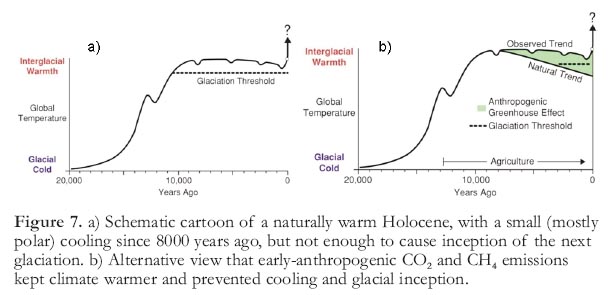Series
The Geoscience of Climate and Energy 2.
Climate Changes at Geologic Time Scales: An Overview
William F. RuddimanDepartment of Environmental Sciences University of Virginia Charlottesville, VA, 22904, USA
rudds2@ntelos.net
1 Exploration in recent decades has defined the basic outline of climate change over a range of time scales from tectonic (millions of years or more) to orbital (governed by changes in the earth’s orbit around the sun over tens to hundreds of thousands of years) to suborbital variations over millennia, centuries and decades. In each case, greenhouse-gas variations appear to have played a major role.
2 Over tectonic time scales, potential climatic drivers include, i) changes in positions of continents; ii) elevation of plateaus and mountains; and iii) isthmus connections between land masses. During the well-defined changes of the last 50 million years, both poles experienced major cooling, marked by shifts to successively colder-adapted vegetation types and eventually the appearance of ice sheets. One index of these changes is the shifts in benthic foraminiferal δ18O trends toward heavier values (colder deep-water temperatures, greater ice volume; Fig. 1).
Figure 1. Benthic foraminferal δ18O trend toward heavier values during the last 50 million years (from Ruddiman 2007, after Miller et al. 1987).
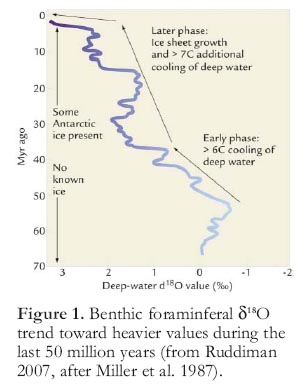
Display large image of Figure 1
3 Opening of full circum-Antarctic ocean circulation is often cited as the cause of Antarctic cooling, but simulations with general circulation models do not support this hypothesis. Instead, cooling of both poles since 50 million years ago is now widely attributed to a gradual decrease in atmospheric CO2 concentrations. One proposed driver of this trend is reduced CO2 delivery to the atmosphere because of a slowing of seafloor spreading rates, but reinterpretations of paleomagnetic anomalies in the northwest Pacific Ocean have now brought Cretaceous spreading rates surprisingly close to modern values. Another (still viable) proposed forcing is increased CO2 removal by enhanced chemical weathering of silicate rock debris produced by uplift in Tibet, the Himalaya and the Andes.
4 Over orbital time scales, changes in Earth’s climate are driven by variations in tilt (obliquity) and by eccentricity-modulated changes in precession. These orbital changes drive two major components of the climate system: ice sheets in subpolar northern latitudes, and monsoons in the tropics and subtropics. Benthic foraminiferal d18O time series in marine sediments show large ice-volume changes at orbital periods during the last 2.75 million years, but the relative amplitudes of the ice-volume changes are not well matched to those of the periods at which the orbital changes drive changes in solar radiation that reach Earth’s atmosphere and alter Earth’s climate (Figs 2, 3).
Figure 2. Variations in benthic foraminferal δ18O during the last 2.75 million years (from Ruddiman 2007, after Raymo 1994).
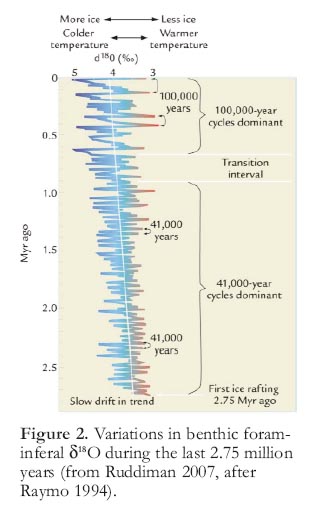
Display large image of Figure 2

Display large image of Figure 3
5 High-latitude insolation variations have both a substantial 23 000-year (precession) component, as well as a 41 000-year (tilt) component. In contrast, ice volume varied mainly at the 41 000-year period from 2.75 to 0.9 million years ago, and then primarily near the 100 000-year (eccentricity) period during the last 900 000 years (Figs. 2, 3). The cause of this mismatch is under active investigation. Because atmospheric CO2 varies in close concert with ice volume (Fig. 4), greenhouse gases are a likely part of the explanation.
Figure 4. Close correlation of ice volume (δ18O) and CO2 signals over the last 400 000 years (from Ruddiman 2007, after Petit et al. 1999).

Display large image of Figure 4
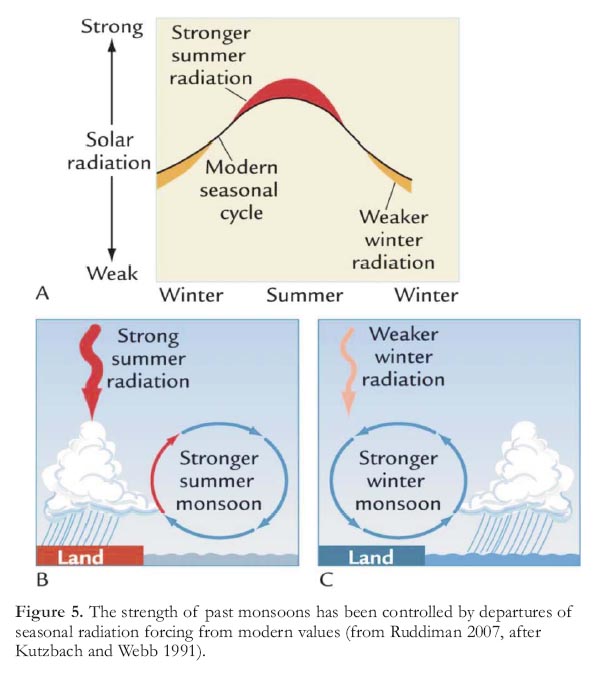
Display large image of Figure 5
6 Variations in tropical monsoon strength over the last 15 million years are relatively well understood. Kutzbach (1981) proposed that past changes in low-latitude summer insolation at the 23 000-year period control the intensity of summer monsoons in the tropics and subtropics (Fig. 5). This mechanism is a direct amplification of the way that strong summer-season insolation (compared to weak winter insolation) drives modern monsoons.
7 Past monsoon variations are registered in a range of proxy data from the tropics, including the size of lakes and the distribution of vegetation types in discontinuous sedimentary sequences. Dramatic recent evidence for monsoon behavior comes from long calcite (speleothem) sequences accurately dated by Th/U analysis (Fig. 6). In full agreement with the Kutzbach hypothesis, large-amplitude d18O variations in cave calcite that can only reflect changes in monsoonal air masses occur at the same period (23 000 years) as insolation changes at tropical/subtropical latitudes and with the predicted mid-summer phase. These changes in the wet summer monsoon control fluxes of methane from tropical wetlands.
Figure 6. Long-term δ18O variations (jagged coloured line) in speleothem calcite from Shangbao Cave in south-central China are dominated by a 23 000-year response that reflects mid-summer insolation at latitude 65°N (smooth grey line) (from Wang et al. 2008).
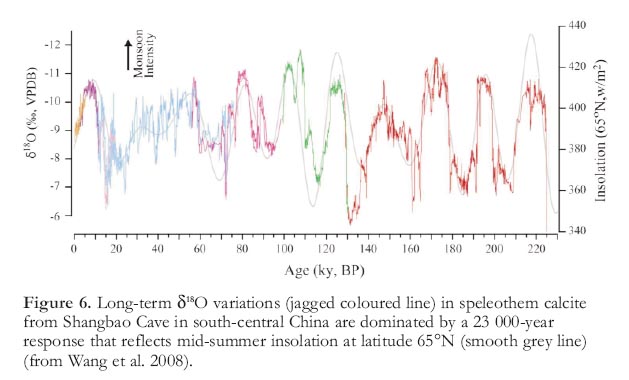
Display large image of Figure 6
8 Large millennial-scale oscillations occurred during times when major ice sheets were present in the northern hemisphere, but they have been much reduced in amplitude and spatial coherence during warmer inter-glacial climates. For the most part, these oscillations are not periodic. They appear to be a manifestation of "red-noise" interactions internal to the climate system. They probably reflect natural random variations around an average climatic state, rather than changes driven by a sustained external source.
9 The Holocene interval began near the end of the most recent melting of northern ice sheets in response to a summer insolation maximum 11 000 years ago, supplemented by coincident CO2 and CH4 maxima. A longstanding view of the climate-science community is that the Holocene remained in a naturally interglacial state because summer insolation and greenhouse-gas concentrations have not yet fallen far enough to initiate the next glacial interval. A different view (Ruddiman 2003) is that early agriculture generated sufficient amounts of CO2 (from deforestation) and CH4 (from rice irrigation, livestock, and biomass burning) to reverse a natural downward trend in greenhouse-gas concentrations during the millennia prior to the industrial era and instead cause a slow rise. In this view, early anthropogenic interference countered a natural cooling trend that would have caused glacial inception by now (Fig. 7).
Figure 7. a) Schematic cartoon of a naturally warm Holocene, with a small (mostly polar) cooling since 8000 years ago, but not enough to cause inception of the next glaciation. b) Alternative view that early-anthropogenic CO2 and CH4 emissions kept climate warmer and prevented cooling and glacial inception.REFERENCES
Kutzbach, J.E., 1981, Monsoon climate of the Early Holocene: Climate experiment with Earth’s orbital parameters for 9000 years ago: Science, v. 214, p. 59-61.
Kutzbach, J.E. and Webb, T. III, 1991, Late Quaternary climatic and vegetational change in eastern North America, in Shane, L.C.K. and Cushing, E.J., eds., Quaternary Landscapes: University of Minnesota Press, Minneapolis, 229 p.
Miller, K.G., Fairbanks, R.G., and Mountain, G.S., 1987, Tertiary oxygen isotope synthesis: Sea level history and continental margin erosion: Paleoceanography, v. 2, p. 1-19.
Petit, J. R., Jouzel, J., Raynaud, D., Barkov, N.I., Barnola, J.-M., Basile, I., Bender, M., Chappellaz, J., Davis, M., Delaygue, G., Delmotte, M., Kotlyakov, V.M., Legrand, M., Lipenkov, V.Y., Lorius, C., Pepin, L., Ritz, C., Saltzman, E., and Stievenard, M., 1999, Climate and atmospheric history of the past 420,000 years from the Vostok ice core: Nature, v. 399, p. 429-436.
Raymo, M.E, 1994, The inititiation of northern hemisphere glaciation: Annual Reviews of Earth and Planetary Sciences, v. 22, p. 353-383.
Ruddiman, W.F., 2003, The anthropogenic greenhouse era began thousands of years ago: Climatic Change, v. 61, p. 261-293.
Ruddiman, W.F., 2007, Earth’s Climate: Past and Future (Second Edition): W.H. Freeman Company, NY, 465 p.
Wang, Y., Cheng, H., Edwards, R.L., Kong, X., Shao, X., Chen, S., Wu, J., Jiang, X., Wang, X., and An, Z., 2008, Millennial- and orbital-scale changes in the East Asian monsoon over the past 224,000 years: Nature, v. 451, p. 1090-1093, doi:10.1038/nature06692.
